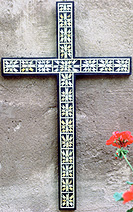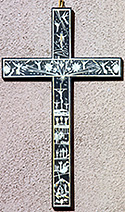Eliseo and Paula Rodriguez

Photo by Jack Parsons
Bio
During the 1930s while working for the government's Works Progress Administration Federal Arts Project, Eliseo Rodriguez learned the rapidly disappearing tradition of straw appliqué. Sometimes referred to as "poor man's gilding" this was a Spanish colonial art form found in the villages of northern New Mexico that uses straw to emulate gold leaf in the decoration of crosses and retablos (religious screens) found in the churches. By the 1950s Eliseo and his wife Paula, who he also taught, were the last remaining practitioners of straw appliqué in New Mexico. However, in the 1970s a conservator at the Museum of International Folk Art discovered their work and encouraged them to show their pieces in the Spanish Colonial Arts Society's Spanish Market. Due to this exposure and publicity and their willingness to teach others, including members of their own family, straw appliqué is once again a thriving tradition in northern New Mexico. One writer has said of the inspired work of Eliseo Rodriguez, "...true spirit doesn't give figurative speeches. It sings in golden figures."
 |
 |

